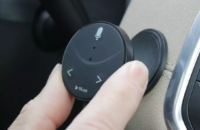
A group of former Samsung engineers is putting their heads together to create new a device called Glamos. It uses LIDAR technology to turn just about any screen into a fully interactive touchscreen.
Well, it functions as a touchscreen of sorts, but you don’t actually have to touch anything to interact with it. Instead, Glamos detects motion and sends a signal to the device telling it what to do.
This creates a situation where a user can control a laptop, smart TV, smartphone, or tablet without actually needing to put their hands on anything but the air within a 180-degree area. For devices with a touchscreen already installed, this will let users interact with them from a distance, which could prove useful for situations where their hands are dirty or they’re doing a presentation from the other side of the room. An example cited by the creators is using a tablet to manage a recipe. Instead of washing their hands to change pages, the user can swipe the air, keeping their tablet clean.
For devices without a touchscreen, the potential use cases are even greater. A smart TV could be controlled without a remote with the user simply “tapping” parts of the air that coincide with locations on the screen. Instead of using a clicker, a presenter could change slides on a projector with a gesture in the air. Not only could that be more convenient, but it also looks like something out of Star Trek. This could turn any TV played on a TV in a Wii-like motion game without much effort on the part of the user.
There are a few things that make Glamos stand out from other devices. First, it has a greater range. It can sense a user’s motion within a three-foot radius, which means it can scale to different size screens — a large TV or a small smartphone would both function with this device. Its rotating mirror motion sensor allows it to capture motion in a 180-degree area, which the company claims is far greater than other devices on the market.
Glamos will work with all smart TVs, Android, iOS, Mac, and any PC running Windows 7 or later. Outside of those limitations, it’s basically up to the user to get creative as to how they can adapt the device to their lifestyle.
LIDAR technology is often found in self-driving cars and robot vacuums, so it’s a reliable piece of tech. The biggest difference between what’s used in those devices and Glamos is the size — the team has found a way to substantially shrink the device down. This means users could carry it around in their pockets rather than needing an entire bag to lug it around. It’s only 1.5 inches by 1.3 inches.
When it ships in August, there will be two different versions of Glamos available. First, there’s the Basic, which connects to the user’s devices via a cable. This version is set to sell for $129. The Pro version works with either a cable or Bluetooth (it only has two hours of battery life when connected wirelessly) and sells for $149.
It’s important to note that this is still a crowdfunding project, so backers who put down their money are by no means guaranteed to actually receive their devices when August rolls around. The company does have a working prototype, but there are always snags that can pop up during production that can cause a project to be delayed or completely canceled.










No comments:
Post a Comment